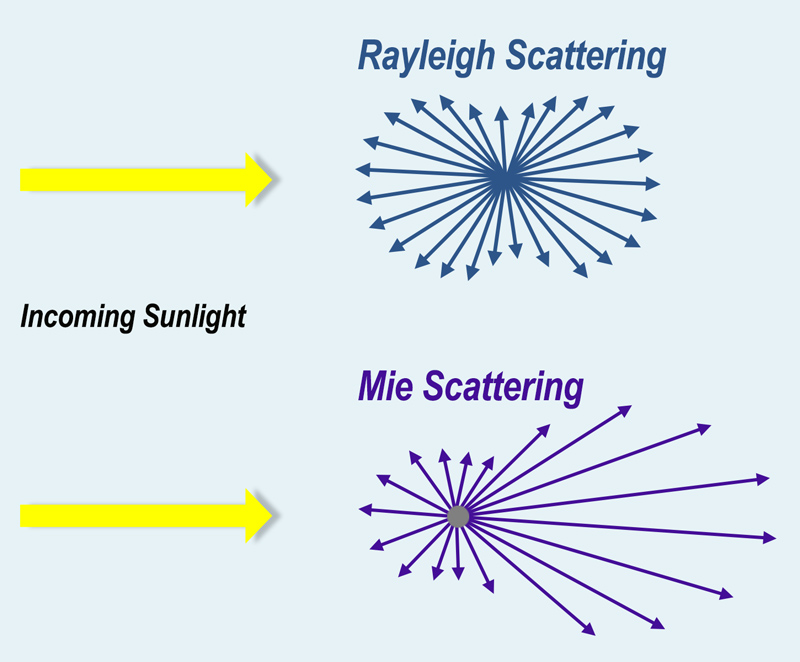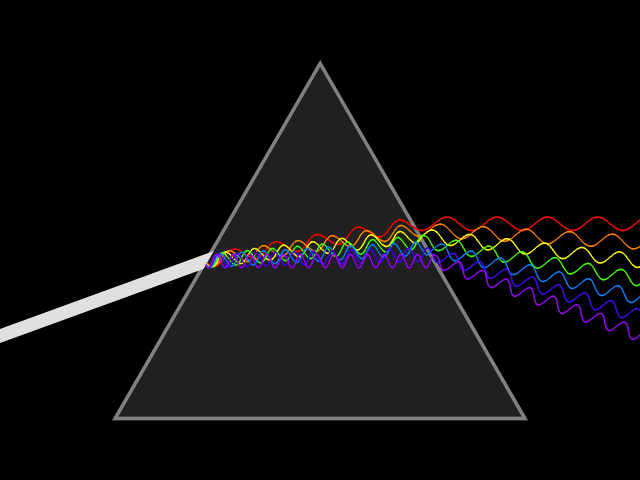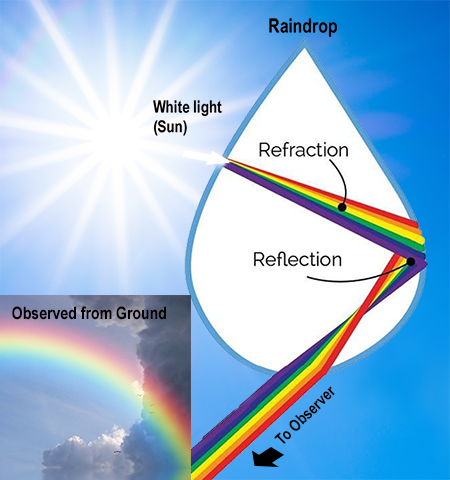Shedding Light on PACE
Section I: Fundamental Properties of Light
What is Light? | How is Light Categorized? | How Does the Light Move or "Behave"? | Advanced Topic - Types of Scattering | How Do Rainbows Work?
What is Light?
Light surrounds us each day, but what exactly is it? A particle? A wave? Unfortunately, depending on the property being investigated, the answer varies from "one", "both", to "neither" as well as "we're not quite sure."
We sometimes define a "particle" of light as a photon, though unlike an actual particle, it does not have any mass. Or we may define the way light moves as a wave, but unlike other familiar waves – such as ocean or sound waves – light energy doesn’t have to travel through a physical medium like air or water… it can travel in the vacuum of space! This complex puzzle is still being unraveled, but what the scientific world does know can be explored in the Ocean Optics Web Book .
While we cannot precisely point to what exactly light is, we have gotten quite good at describing what light does. For example, whether we define light in terms of photons or waves, we know that it moves at very high speeds: 671,000,000 mph! In fact, it is impossible for anything to travel faster than light. See 10 Things Einstein Got Right to learn more!
We can also describe and categorize light. We do this based on its wavelength, which can also be expressed in terms of frequency. Wavelength is the distance between two crests (tops) or two troughs (bottoms) of the waves. Frequency is how many wavelengths pass a given point per second. Longer wavelength light has lower frequencies and less energy. Conversely, shorter wavelength light has higher frequencies and is more energetic. Now that we’ve addressed how wavelength and frequency are related, let’s explore different types of light with a focus on wavelength.


How is Light Categorized?
This spectrum of energy, or spectrum of light, is referred to as the Electromagnetic Spectrum. NASA explores the properties of different wavelength regions in the electromagnetic spectrum ranging from radiowaves to gamma rays. Right around the middle of the spectrum we have visible light - the rainbow of colors we know and love. Just shorter than visible light are the ultraviolet wavelengths, which we wear sunscreen to protect ourselves from. Just longer than visible light is infrared, which we sense as warmth on our skin.
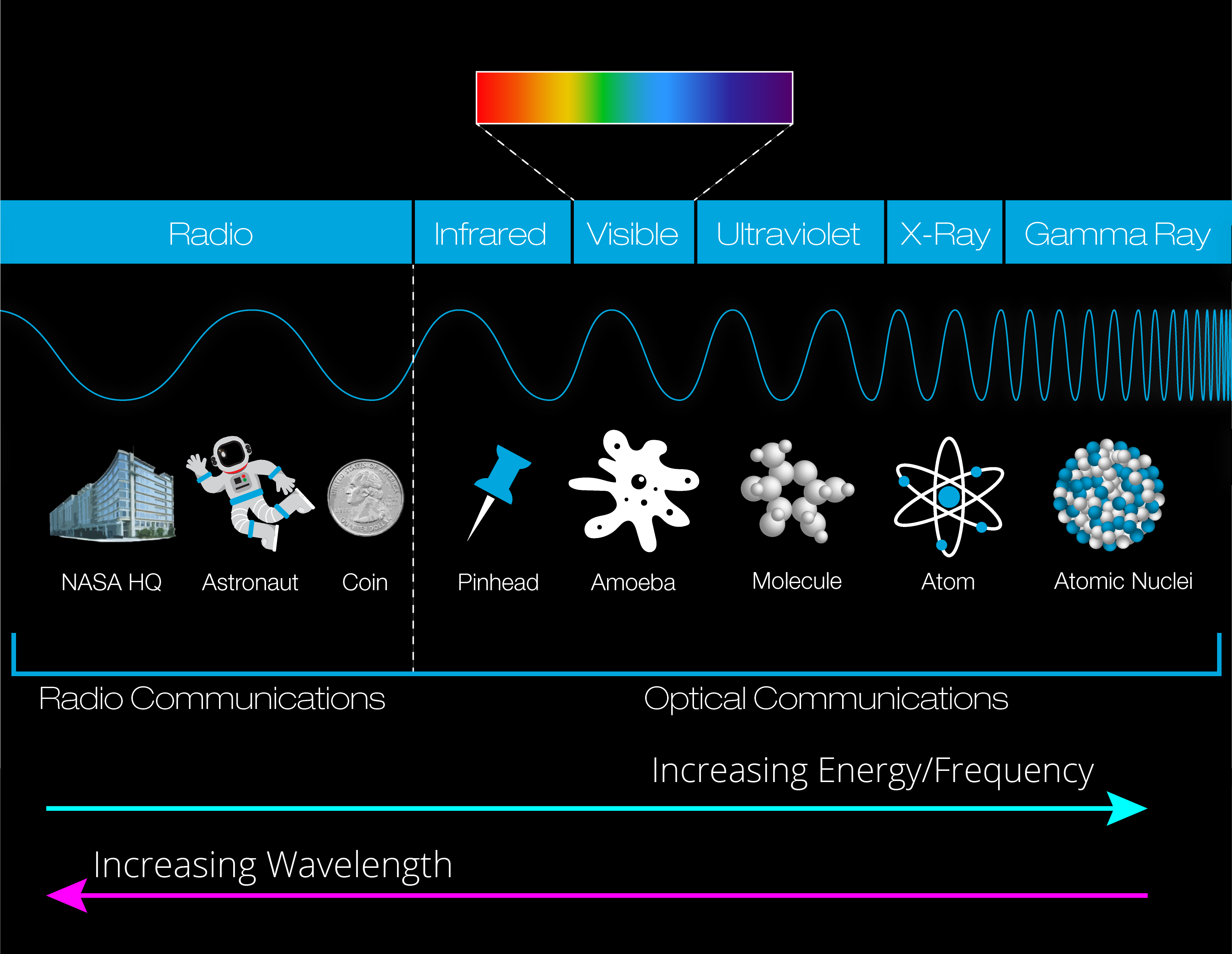

Let's look closer at the visible light portion of the spectrum. Blue light is more energetic than red light; i.e., it has a shorter wavelength than red light. Specifically, we can say that blue light wavelengths are between 450-490 nanometers (nm) long whereas red light is 620-750 nm long. One nanometer is the equivalent of 0.000000001 meters. When discussing how light interacts with the ocean and atmosphere, we often refer to wavelengths in terms of nm.
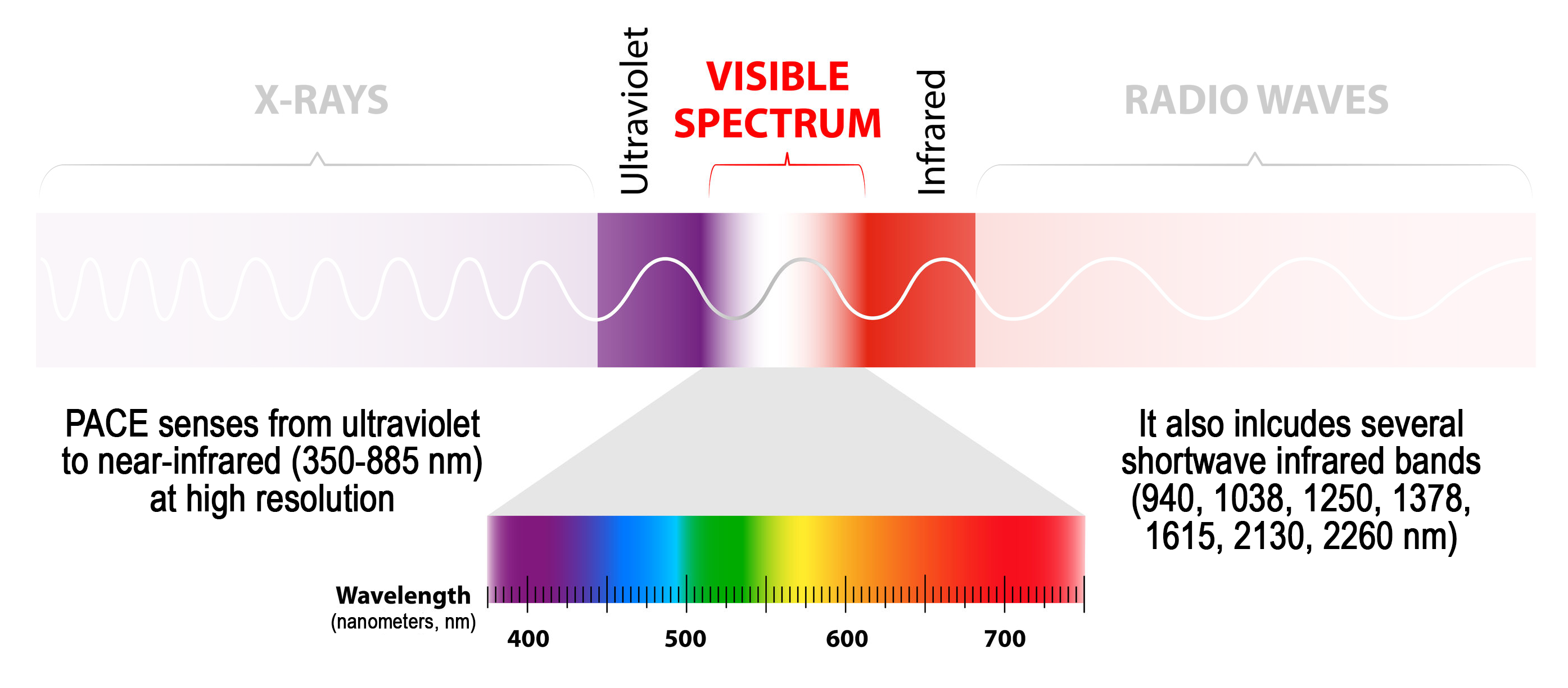

PACE measures light over a broader range of the electromagnetic spectrum and with more precision and detail than ever before. PACE's fine-resolution measurements, known as hyperspectral imaging, provides new insights into our ocean and atmosphere. Want to learn more? Check out the Colorful World e-brochure.
How Does Light Move or "Behave"?
Most of the light reaching earth comes from our Sun. It is generated by nuclear reactions in the Sun's core that convert hydrogen into helium, releasing energy (photons!) in the process. For more information on how light is produced by the Sun, check out the Ocean Optics Textbook .
When there are no obstacles in its path, light travels in straight lines that extend in all directions from its source (like the surface of an expanding sphere/ball). Once light encounters an obstacle – say a molecule of carbon dioxide, the leaf of a plant, or an asphalt road – it will interact with that object in one of several ways. Check out the Sea the Light e-brochure for more information.
Transmission of light waves occurs when light waves pass through an obstacle without a change of direction (e.g, a pane of glass or clear plastic). Obstacles that allow light to pass through unimpeded (unchanged) are called… you guessed it: transparent! The opposite of transparent is opaque, wherein light is unable to to penetrate an object and instead creates a shadow.
Absorption occurs when photons from incoming light hit atoms and molecules in the object (e.g., pavement) and cause them to vibrate. The more an object's molecules move and vibrate, the hotter they become. If enough energy is absorbed, it may then be re-emitted from the object as infrared, or thermal energy (at a lower energy level than incoming light). Infrared cameras have sensors that measure the amount of heat emitted from objects, and display the results as thermal images.
Scattering occurs when a photon of incoming light hits an object and bounces off it in one or many directions. Scattering can change the wavelength of the light or leave it unchanged.
Reflection occurs when incoming light hits an object and is redirected in a new and predictable direction. Smooth surfaces, like mirrors, or the still surface of a pond, reflect almost all light, which is why we can easily see our… you guessed it… reflection.
Refraction occurs when light slows down very slightly and changes direction as it passes from one medium to another with a different density. This occurs, for example, as light travels between air and water. Refraction is why a pencil, partially submerged in a glass of water looks as if it has been bent. The change in direction is predictable if you know the densities of the materials that light is traveling through.
Put simply, diffraction refers to light breaking up into many pieces and going in many directions. Diffraction occurs when light waves encounter an object that causes the light waves to "spread out" around and beyond the edges of the object. For example if you were to hold up a compact disc (CD) and digital video disc (DVD) in the sunlight, the minutely spaced bumps on the disk would diffract incoming light to form a rainbow pattern. Another visual representation of this effect how ocean currents diffract around a jetty.
Understanding how objects interact with light at various wavelengths is key to deciphering the signals leaving earth's surface. By observing light at more wavelengths with higher precision, PACE scientists may be able to discover more about our atmosphere and ocean than was previously possible. Want to learn more? Check out this StoryMap about PACE’s novel instrumentation. Take a deep dive into Radiative Transfer Theory in the companion pages PACE – It All Adds Up! .
Advanced Topic - Types of Scattering
Scattering occurs when light bounces off an object in a variety of directions. The amount of scattering that takes place depends on the wavelength of the light and the size and structure of the object. Click here for more of an overview on scattering .
If an object is very small, like a molecule of oxygen or nitrogen in the atmosphere, then we are looking at Rayleigh scattering. With Rayleigh scattering, light is scattered close to uniformly off the object in all directions. The small molecules preferentially scatter shorter light wavelengths, hence our blue skies.
But what about bigger particles in the atmosphere like dust or cloud droplets? Larger particles interact with light via Mie scattering. Mie scattering causes that hazy glow we recognize in sunsets over cities with severe air pollution and lots of aerosols. Unlike Rayleigh scattering, Mie scattering sends light more strongly in the forward direction and has a weaker wavelength preference in its scattering.
Looking for a deeper dive? Read more about the Scattering in the Ocean Optics Web Book
Want to see this scattering in the sky? Check out the images in The Color of Clouds (NOAA) and Crepuscular Rays and Light Scattering (NASA).
How Do Rainbows Work?
Do you have a rainbow connection? While rainbows symbolize peace for many modern cultures, they are also fascinating optical studies. Rainbows are multicolor displays created by sunlight shining through raindrops. But the light performs some interesting tricks inside those raindrops before colors burst out the other side! Light rays entering raindrops undergo refraction at the initial surface of the raindrop, which bends the light rays, but also causes a separation of the light into the distinct colors of the visible spectrum, a process called dispersion, seen in the animation below.
These raindrops are acting like optical prisms, or "white light splitters". You may be familiar with the acronym, ROYGBIV (red, orange, yellow, green, blue, indigo and violet)? This denotes the predictable order of the light wavelengths that occur when dispersed/refracted. More energetic wavelengths (e.g., violet) slow down slightly more than the less energetic wavelengths (e.g., red). Back inside our raindrop example, the dispersed light is reflected off the back of the raindrop, and refracted once again as it exits the raindrop back into air, and then travels to our eyes. Did you know that rainbows occur in the section of the sky opposite the Sun? So next time you want to see a rainbow, make sure to turn so the Sun is at your back.



